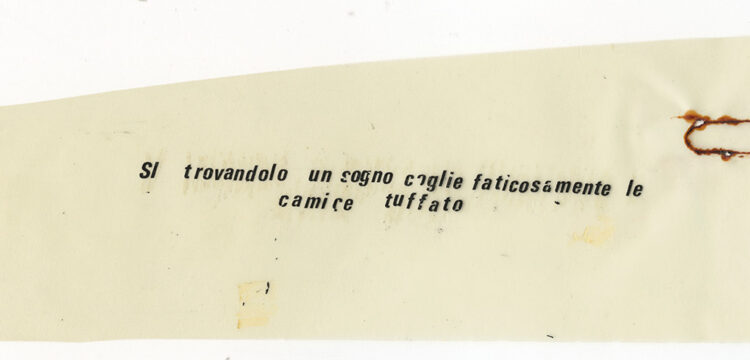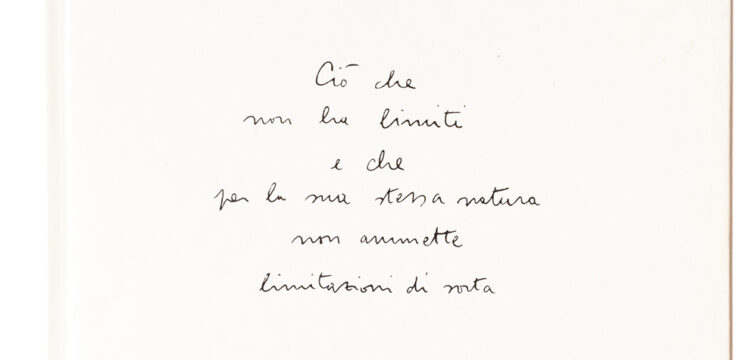On the Conservation of Poetry
Archive Actualized #8: A conversation with Fondazione Morra
The eighth appointment with Archive Actualized is the result of a long conversation with different voices that has taken place over the last few months with Fondazione Morra. The dialogue involved the Archive’s Scientific Director Domenico Menillo and curator Eva Fabbris with the aim to explore not only the materials in a collection that has been consolidated since the 1970s with the foundation of Studio Morra by Giuseppe Morra, but also to look towards the future and the increasingly strong focus on language as artistic practice today.
REPLICA: One of the most complete and important collections of works by the artist Arrigo Lora Totino, one of the greatest interpreters and exegetes of international concrete and sound poetry, is owned by Fondazione Morra. It was in the late 1980s, thanks to the Temperature Flegree event, that the Foundation began a lasting relationship with the artist, which culminated in 2018 when Fondazione Morra acquired Totino’s private archive. Can you tell us something about this fund, what it contains, and how it is organized, conserved and enhanced?
Domenico Mennillo: The Arrigo Lora Totino Fund, curated under my scientific direction, is currently being cataloged; the Fund contains within it sections an in-depth study of many phenomena linked to performance and visual and concrete poetry of the second half of the 20th century. In particular, the Fund contains Arrigo Lora Totino’s epistolary, with letters exchanged with authors such as Raul Haussman, François Dufrene, Max Bense, Francesco Cangiullo, Carlo Belloli, Henri Chopin, Bernard Heidsieck, Pierre Garniere, Jean-François Bory, Franz Mon, Dick Higgins, Adriano Spatola, Stelio Maria Martini, Luciano Caruso, Sarenco and many others. The vast majority of these letters are technical; in them, we find invaluable information about the organization of poetry festivals, the publication of magazines and volumes related to the experiments of the Italian and international artistic Neo-Avant Gardes, as well as in-depth studies on individual topics related to Avant Garde poetry. From this point of view, I believe that this epistolary has few equals in the world and Italy in particular, also because Totino had a perfect command of English and French, so all the letters he exchanged with his interlocutors are extremely detailed and precise; Indeed, I believe that the very fact of mastering a language such as French, a language that was practically at the centre of the greatest experimentation in the field of poetry throughout the 20th century, allowed Totino access to information that was little known and widespread, and in some cases, such as Henri-Martin Barzun’s Simultaneism, he succeeded in giving this phenomenon and its author the attention it deserved at an international level, starting in the 1970s, both of which were fundamental for all the subsequent innovations in international avant-garde poetry, but also in painting, performance and experimental music. In addition to Totino’s studies on Barzun, the Arrigo Lora Totino Fund also preserves several documents that Totino himself brought from Columbia University, related to the poem L’Orphéide ou L’Universal Poème, still inexplicably unpublished worldwide.
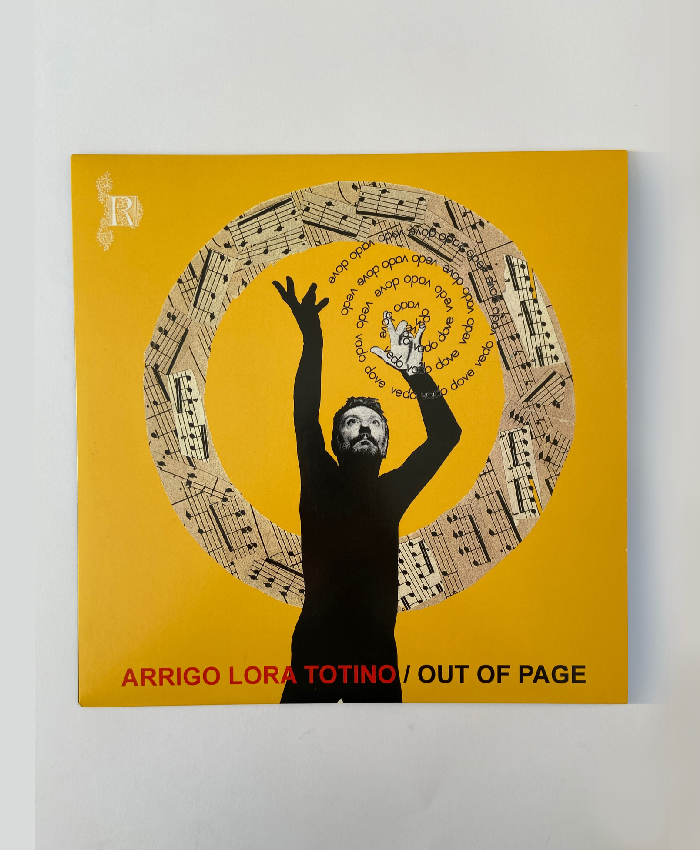
Within the Arrigo Lora Totino Fund we also find sections dedicated to the preservation of Totino’s professional documentation, with autographed writings related in particular to the realization of performances, volumes and artist’s books, some of which have remained unpublished to this day; as well as printed documents testifying to his impressive production over 50 years of activity, with posters, invitations, playbills, etc. The Fund is completed by sections dedicated to photographic documents, audio and video documents, multiples and graphic works, mostly dedicated to Totino’s artistic production and in some cases also to the production of authors with whom Totino collaborated. Lastly, part of the Fund includes part of Totino’s private library, with around 800 volumes, also related to the verbo-visual experimentation of the 20th-century neo-Avantgardes, with editions that are practically impossible to find today.
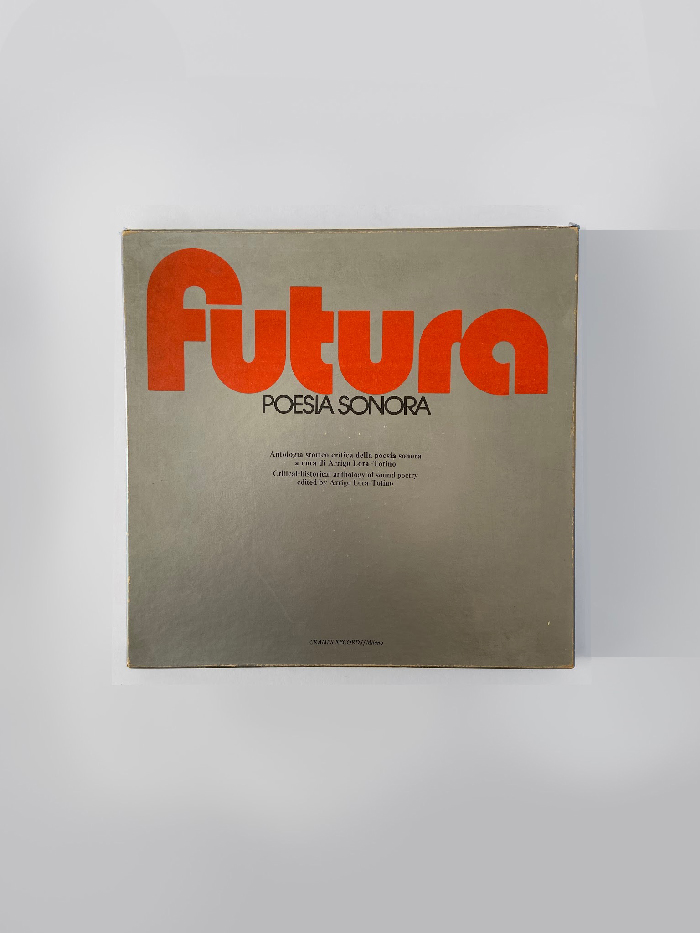
REPLICA: Of considerable value and importance is certainly the publishing aspect of the Fondazione Morra, which can boast of having produced hundreds of catalogs and art books, today the desire of every bibliophile and collector. A cult book, which has now entered artistic historiography, is the second edition of Neurosentimental by Stelio Maria Martini, one of the most important exponents of visual poetry. What were the reasons that prompted you to produce a second edition twenty years later? Are there any differences with the first one?
Domenico Mennillo: The republication of Neurosentimental, or rather its second edition, stems from the friendship between Giuseppe Morra and Stelio Maria Martini, a collaboration that began in the 1970s with the publication of the single issue of the magazine Silence Wake, edited by Martini with Luciano Caruso and published by Morra himself. This collaboration has seen many other moments over the years, with the organization of meetings and exhibitions to which Martini and Morra dedicate themselves with continuity, involving the major authors of international visual poetry. The translations of Henri Chopin’s major works published for Morra Editions, for example, are also by Martini, to which Martini adds critical profiles of great acuity, giving those approaching these innovative and disruptive works for the first time the possibility of having reading tools of great effectiveness and at the same time a high scientific profile. Again with Morra Editions, Martini published all his most important visual works (Schemi, one of the fundamental and central texts of international visual poetry, Formulazioni non-A, and the aforementioned Neurosentimental) and many of his theoretical writings produced between the 1990s and 2000s. As far as Neurosentimental is concerned, the second edition published by Morra Editions is revisited by Martini himself through some additions that were not present in the first edition; we are talking specifically about visual poems or, as Martini liked to define them, “collage-poems” so that the second edition is a different work from his first edition. Most of the poem collages in Neurosenitmetal, as well as other visual works by Martini, are present in the Morra Foundation’s collections.
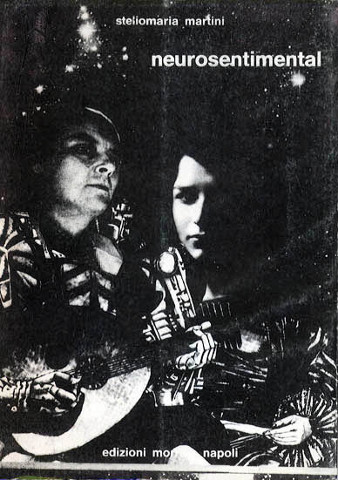
REPLICA: The passion for verbal-visual, concrete and sound poetry is one of the main interests that the Morra Foundation has pursued over time, it is enough to mention just a few of the artists in the collection: Emilio Villa, Ugo Carrega, Henri Chopin, Stelio Maria Martini, Eugenio Miccini, Lamberto Pignotti, Arrigo Lora Totino, Sarenco, Gerhard Rühm, Oswald Wiener, Heinz Gappmayr. Why the closeness to such a niche language and form of expression? Is it a passion linked to authors and artists of the past or does your research continue thanks to newcomers?
Domenico Mennillo: Rather than a niche, Giuseppe Morra’s interests have focused, since his beginnings at Studio Morra in the 1970s, on the most experimental and innovative phenomena of national and international art, linked above all to the combination of art and life, central to all the productions of the first and second world artistic avant-gardes. This perspective includes not only visual poetry but also performance, with authors such as Hermann Nitsch (to whom Morra has dedicated the Museo Hermann Nitsch Archivio Laboratorio per le Arti Contemporanee in Naples) and Shozo Shimamoto, to name just a couple of the artists with whom Giuseppe Morra has had an ongoing working relationship, friendship and collaboration over the years; but it is also important to pay attention to a language such as an environment, with the collaboration with Allan Kaprow or the Living Theatre, to which a specific archive fund with precious and rare documents is dedicated at Casa Morra Archivi di Arte Contemporanea.
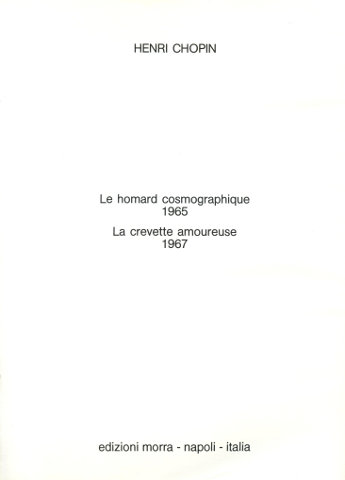
As for your second question, I believe that the Neo-Avant Garde artistic movements linked to the phenomena of visual poetry exhausted their drive and innovation at the end of the 1970s, but their ideas and thought remain a reference for many new and innovative artistic and aesthetic experiences produced in the last 40 years. The Fondazione Morra has always paid great attention and support to these innovations; over the years, my visual and environmental theatre works, such as the recent cycle of the Abrégé d’Histoire Figurative, linked to many of the most important aesthetic theories of the second artistic avant-gardes, have often been supported by the Fondazione Morra; as well as the initiatives of the International Festival of Electronic Music La Digestion – music rarely heard, realized by Renato Grieco, Mimmo Napolitano and Giulio Nocera, young musicians and composers engaged in a personal reinterpretation of the phenomena linked to the international sound music of the neo-avant-gardes.
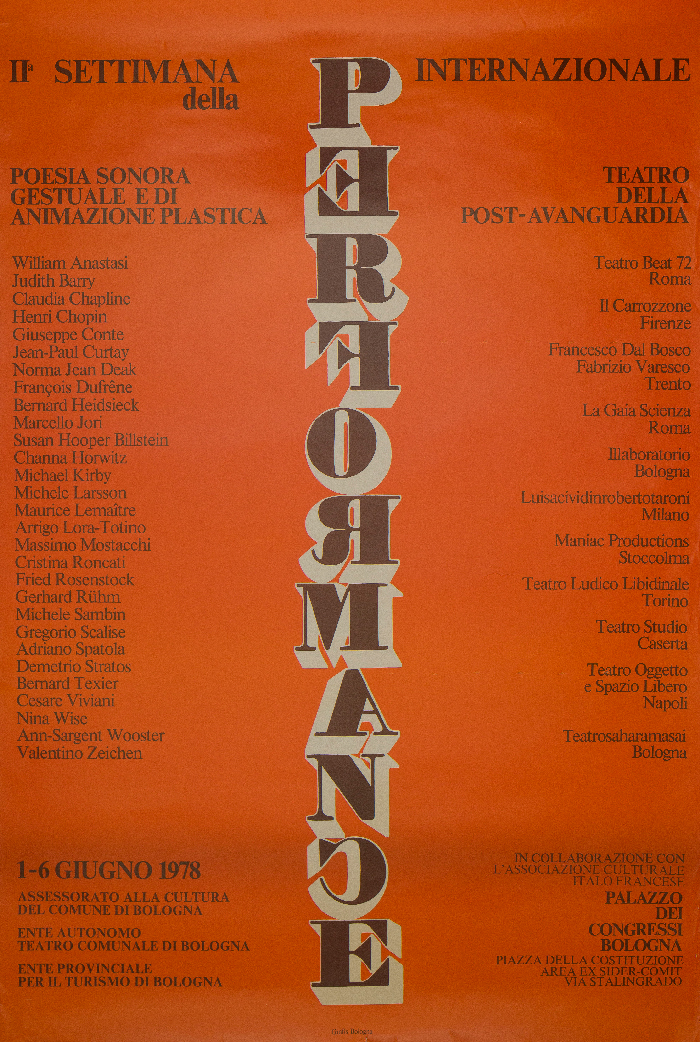
REPLICA: An aspect that interests us, particularly in the case of your archive is that of performance, which in many cases has been translated and converted into record publications such as the Radiotaxi series published by Studio Morra and Lotta Poetica. What close connection do you see between the artist’s book or artist’s vinyl and a performance act? Why do you often turn to this specific form of publication as your form of survival and documentation?
Domenico Mennillo: Although in continuity with some of the languages and experiences you mentioned, the artist’s book and vinyl go in two different directions. The artist’s book was born, especially with the artistic Neo-Avant Gardes (obviously inspired by some exceptional examples already realized by the historical Avantgardes), as a vision of the world and together with the book object, a similar but different language, they aspire to become the world, to encompass the whole world in a book, taking up the suggestions evoked by Mallarmé’s theories. From the artistic Neo-Avant Gardes of the second half of the 20th century to the present day, it is practically impossible to map all the innovations and proposals contained in the myriad of artist’s books, multiples or single copies, produced by artists and poets; which suggests that Mallarmé’s prophecy is slowly being fulfilled and that perhaps one day it will be the world itself that will have to construct its own artist’s book to be able to tell its own story universally.
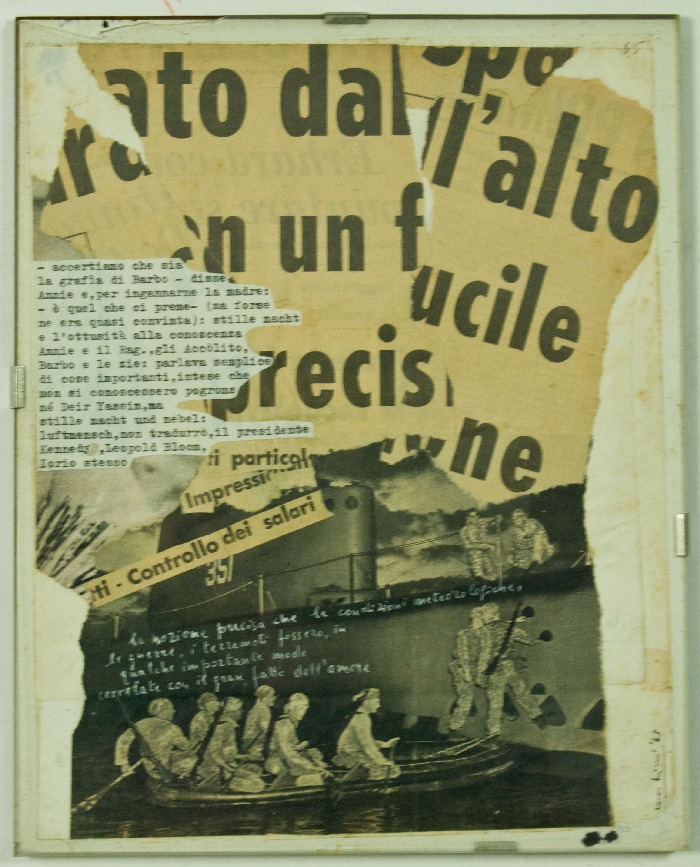
Instead, the vinyl becomes the possibility of giving the ephemeral, lyrical and dispersive moment of the sound performance a concrete statute; at the same time, if not even before the performance itself, the vinyl becomes the possibility of being able to experiment in the “non-inclusive” space of the recording studio (unlike the space of the performance, which is almost always intended as a space shared with other people other than the artist operating in the performance itself) various creative possibilities that sometimes become, at a later stage, a track for a sound performance. But as for performance, also for vinyl, the crossovers and hybridisations are innumerable and probably today one of the reasons for their powerful fascination on us contemporaries is precisely this field of great expressive freedom that other disciplines or more “classic” and orthodox media hardly allow.
Certainly, both the artist-object book and the vinyl have contributed to giving continuity today to the flow of visions and information created by the artistic avant-gardes, making it possible to preserve and above all transform and “betray” their visions into new and unprecedented paths, an aspect that I believe is contained, sometimes in an explicit and bombastic manner, in the works and theories of the greatest avant-garde interpreters of the last century.
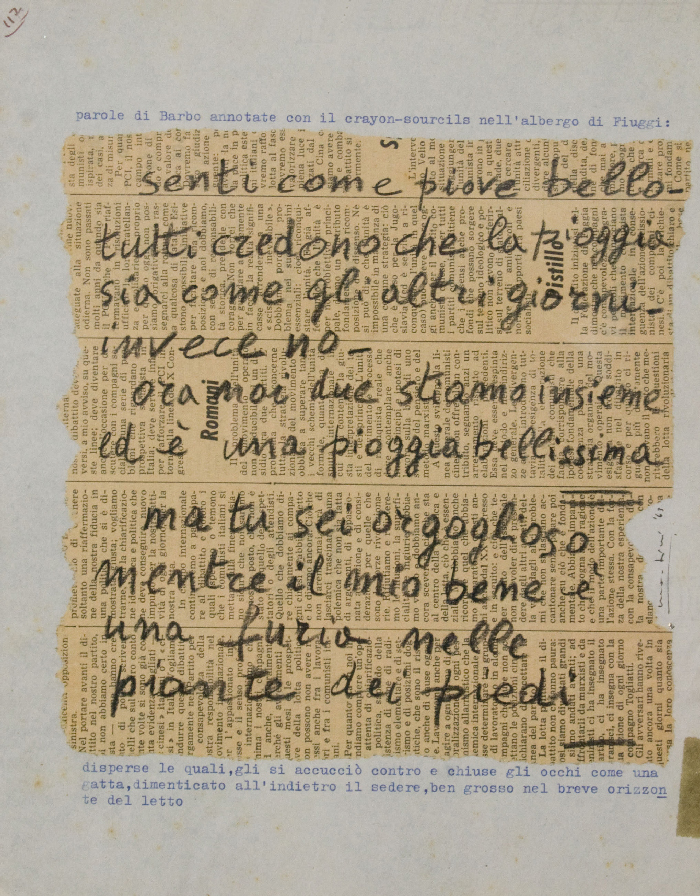
REPLICA: We believe that visual poetry on the Italian but also the international scene is still a niche subject, although there have been some recent developments and cases of in-depth study.
How did you decide to shape Pre Post Alphabet, a section dedicated to young artists within the initiative La scrittura visuale/La parola totale curated by Giuseppe Morra and held in Naples, at Museo Nitsch (another branch of Fondazione Morra) in 2014? According to what criteria did you match specific materials to the artists?
Eva Fabbris: Pre Post Alphabet was my first opportunity to collaborate with Fondazione Morra. Ever since then, I have been able to identify its vital potential: the past is preserved, studied and exhibited there, being understood as the essential root of a vibrant present, which should be supported and highlighted even in events focusing on a historical dimension.
Gigiotto Del Vecchio and I for PPA have chosen artists, or individual works, that we believe act in aesthetic continuity with the positions identified by Peppe Morra for the “historical” part of the exhibition, but no specific juxtapositions have been identified. We did not look for precise and univocal parallels between the figures of the different generations; we looked at what was happening by showing them together. The fact that there were many performative moments made the alternation of young and historical figures particularly fluid and unifying. A particularly effective moment of closeness was the dialogue between Vincenzo Latronico and Nanni Balestrini, which ended with the two taking turns reading excerpts from Carbonia. We were all communists, which Balestrini had then just published. Two writers, two collagists of words, two voices on a text: two authors who enjoyed the possibility of identifying with each other.
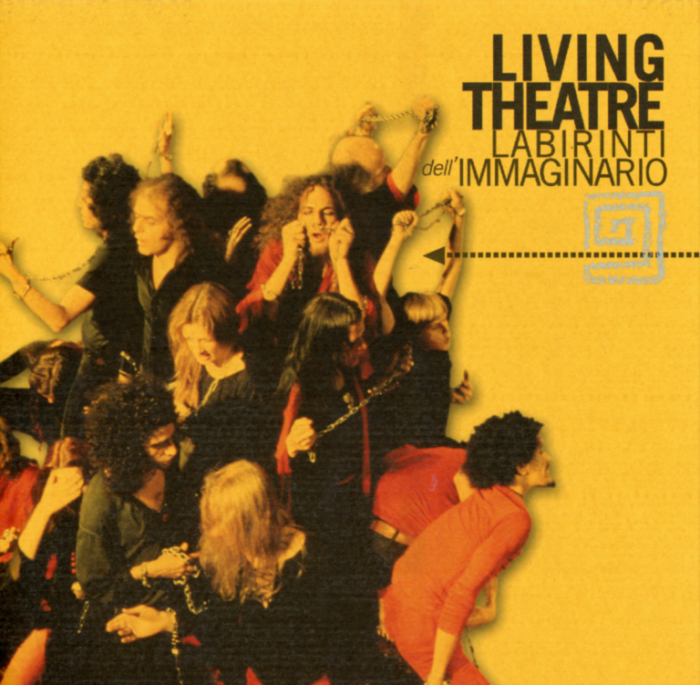
REPLICA: How do you interpret the “linguistic turn”, characterized by extensive experimentation with language (see figures such as Nora Turato, but also, remaining in Italy, Giulia Crispiani or Allison Grimaldi Donhaue), which today seems to have gained a strong interest from the art system?
Eva Fabbris: I am not sure that this is a turning point, and I am not even sure that, beyond the specific interest in the figures you rightly mentioned, there is particular attention at the moment for those who use the word.
I prefer to think that the poetic use of the word has become one of the possible languages available to visual artists today thanks to the urgent intuition that took shape from the Symbolist and Dada experiments, to explode in the confrontation with the political temperament of the late 1960s.
REPLICA: One of the issues we consider most interesting about the exhibition of artists’ books and editions is that of the display. What is your position on this specific type of work? How would you make the possibility of understanding them more accessible?
Eva Fabbris: A book is an object that is generally given to the private gaze, for manipulation by the individual. To understand how to display it in the shared dimension of the exhibition, I think you have to be clear about which of its dimensions you want to make more accessible.
For example, I recently found the Fore-edge Painting exhibition at the MACRO very beautiful, which, by having several artists decorate the cut-out of a book that was important to them, seemed to focus on the objecthood of volumes. The display in which they were displayed, one by one, horizontally as if crushed in a press emphasized the inaccessibility of the pages, but precisely because of this it reminded us of how these objects are treasure troves.
In a different vein, I happened to exhibit issue 5+6 of the experimental box-shaped magazine Aspen (from 1967) in an exhibition conceived for the exhibition space of an art school; in that case, I felt it was essential that the focus in showing it should be on the diversity and interactive capacity of the content that Brian O’Doherty as guest editor had brought together. I asked a few artists to synthesize the richness of the magazine in a single photograph (using the shots for the exhibition communication only), and then I displayed the magazine in a display case next to a computer from which the digital version of its various contents could be consulted.
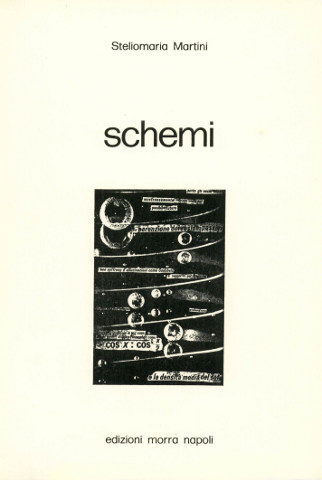
REPLICA: Visual poetry has certainly had a large number of male voices, but it has also left a large space of expressiveness and emotionality for female figures. In today’s context, certainly shaped by the possibility of overcoming gender stereotypes and binarisms, what is your position concerning the practices active in the 1970s? What can they transmit to us?
Eva Fabbris: I find them fundamental and I believe, also in connection with the previous question, that there is important curatorial and scientific work to be done on how to exhibit these practices to do justice to the extraordinary vitality with which they were expressed. A few months ago I visited Tomaso Binga, whom I had first seen perform during La scrittura visuale/La parola totale. She showed me the originals of her extraordinary Alfabetiere with the same enthusiasm with which she immediately showed me the version that primary school children had made of it in a workshop conducted by a teacher Bianca had never met. Receiving these “cards” in which children found her positions, in which they “were” body and letter as she had done, gave her great pleasure. And again, as with Latronico and Balestrini: this is not about younger generations paying homage to their masters, this is about an energy that continues to flow, that transcends historical differences to get to the heart of what is today’s action and speech. Of course, it is fundamental to exhibit the dactylopoems, the letters, the plates, and the collages in which we discovered how to rejoice and understand with eyes, throat and ears together, but the static celebration of the originals must be integrated; the positions must be relived and lived.




